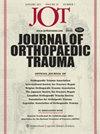Subtrochanteric Femur Fractures: The Association Between Obesity and Perioperative, Clinical, and Radiographic Outcomes
IF 1.6
3区 医学
Q3 ORTHOPEDICS
引用次数: 0
Abstract
To evaluate the association between obesity and treatment approaches, perioperative factors, and clinical and radiographic outcomes following subtrochanteric fracture fixation. METHODS: Design: Retrospective Cohort Academic Medical Center Patients operatively treated for an AO/OTA 32Axa, 32Bxa, or 32Cxa subtrochanteric femur fracture. Outcome Measures and Comparisons: Injury characteristics, perioperative parameters, fixation information, postoperative complications, clinical and radiographic outcomes. Univariable analyses were conducted between the obese (BMI > 30 kg/m2) and the non-obese (BMI < 30 kg/m2) cohorts. Regression analyses were performed to assess BMI as a continuous variable Of 230 operatively treated subtrochanteric fracture patients identified, 49 (21%) were obese and 181 (79%) were non-obese. The average age of the obese cohort was 69.6 ± 17.2 years, with 16 (33%) males and 33 (77%) females. The average age of the non-obese cohort was 71.8 ± 19.2 years, with 60 (33%) males and 121 (77%) females. Aside from BMI, there were no significant differences in demographics between the obese and non-obese (age [p=0.465], gender [p=0.948], ASA Score [p=0.739]). Both cohorts demonstrated similar injury characteristics including mechanism of injury, atypical fracture type, and AO/OTA fracture pattern (32A, 32B, 32C). Obese patients underwent more open reduction procedures (59% open obese, 11% open non-obese, p<0.001), a finding further quantified by a 24% increased likelihood of open reduction for every 1 unit increase in BMI (OR: 1.2, 95% CI: 1.2-1.3, p<0.001). There was no difference in average nail diameter, 1 vs 2-screw nail design, or number of locking screws placed. The obese cohort was operated on more frequently on a fracture table (p<0.001) when compared to the non-obese cohort which was operated on more frequently on a flat table (p<0.001). There were no significant differences (p>0.050) in postoperative complications, mortality/readmission rates, hospital quality measures, fixation failure or time to bone healing. The treatment of subtrochanteric fractures in obese patients is associated with a higher likelihood of surgeons opting for open fracture reduction and the use of different operating room table types, but no difference was observed in postoperative complications, mortality or readmission rates, or healing timeline when compared to non-obese patients. Prognostic Level III. See Instructions for Authors for a complete description of levels of evidence.股骨转子下骨折:肥胖与围手术期、临床和影像学结果之间的关系
目的:评估肥胖与治疗方法、围手术期因素以及转子下骨折固定术后临床和影像学结果之间的关系。方法:设计:回顾性队列学术医学中心接受 AO/OTA 32Axa、32Bxa 或 32Cxa 股骨转子下骨折手术治疗的患者。 结果测量和比较:损伤特征、围手术期参数、固定信息、术后并发症、临床和影像学结果。对肥胖组(体重指数大于 30 kg/m2)和非肥胖组(体重指数小于 30 kg/m2)进行单变量分析。对作为连续变量的体重指数进行了回归分析。在230名接受过手术治疗的转子下骨折患者中,49人(21%)为肥胖,181人(79%)为非肥胖。肥胖人群的平均年龄为 69.6 ± 17.2 岁,其中男性 16 人(33%),女性 33 人(77%)。非肥胖人群的平均年龄为 71.8 ± 19.2 岁,其中男性 60 人(33%),女性 121 人(77%)。除体重指数外,肥胖者和非肥胖者在人口统计学方面没有显著差异(年龄[p=0.465]、性别[p=0.948]、ASA评分[p=0.739])。两组患者的损伤特征相似,包括损伤机制、非典型骨折类型和 AO/OTA 骨折模式(32A、32B、32C)。在术后并发症、死亡率/再住院率、医院质量标准、固定失败率或骨愈合时间方面,肥胖患者接受开放复位手术的比例更高(肥胖患者为59%,非肥胖患者为11%,P0.050)。 在治疗肥胖患者的转子下骨折时,外科医生更有可能选择开放性骨折复位术,并使用不同类型的手术台,但与非肥胖患者相比,在术后并发症、死亡率或再入院率或愈合时间方面未观察到差异。 预后 III 级。有关证据等级的完整描述,请参阅 "作者须知"。
本文章由计算机程序翻译,如有差异,请以英文原文为准。
求助全文
约1分钟内获得全文
求助全文
来源期刊

Journal of Orthopaedic Trauma
医学-运动科学
CiteScore
3.90
自引率
8.70%
发文量
396
审稿时长
3-8 weeks
期刊介绍:
Journal of Orthopaedic Trauma is devoted exclusively to the diagnosis and management of hard and soft tissue trauma, including injuries to bone, muscle, ligament, and tendons, as well as spinal cord injuries. Under the guidance of a distinguished international board of editors, the journal provides the most current information on diagnostic techniques, new and improved surgical instruments and procedures, surgical implants and prosthetic devices, bioplastics and biometals; and physical therapy and rehabilitation.
 求助内容:
求助内容: 应助结果提醒方式:
应助结果提醒方式:


